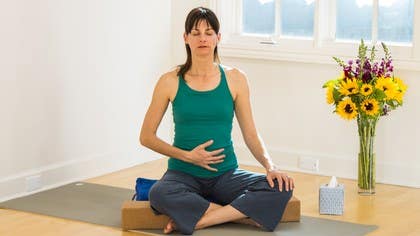Description
About This Video
Transcript
Read Full Transcript
(wave crashes) Hi, welcome back. I'm Margi. This is a seated practice, so it's important that you are seated comfortably, because we are going to be sitting for approximately ten minutes. It's completely fine to sit up in a chair. You can refer to my tutorial that I had on finding your seat.
I give lots of different options for ways that you might be comfortable seated. It's very important though that you're not struggling with back pain or hip pain as you are doing this practice. If it's better for you to lie down, you're also welcome to lie down. The danger sometimes with lying down is people nod off and start snoring, but if you are able to stay awake, you're welcome to lie down. The practice is about an ancient principal called Pratyahara, and it means the sense organs drawing inwards.
2500 years ago, a guy named Patanjali created a text called the Yoga Sutras, which is one of the primary ancient yogic texts, and in this text he lays out the practice of yoga like an octopus with eight legs coming out of it. The first two of these "limbs," they're called, are about living ethically in the world, things like not harming and not stealing, being kind, things like this. The next one is Asana, which is the yoga poses. The next one is Pranayama, which is breathwork. The next one, which is what this is going to be based on, is Pratyahara, which is drawing the senses in, and then there's Dharana, which is focus, concentration, Dhyana is sort of overall awareness, and then the last one is Samadhi, which is enlightenment.
I find it really interesting that Patanjali put this drawing in of the senses as important as meditation, as important as the breathwork, as important as the poses. We'll just see what happens. You can let your eyes gently close. Transition from looking at a screen to coming inside of your own skin. Feel your seat, rooted into whatever it is that you're sitting on.
Anything else touching the ground, imagine there's roots just falling out of your base into the support of the Earth. Touch is one of the senses. Notice the touch of yourself into the ground. Let your hands float up off of your knees for a moment. Open the palms of your hands, and then let your hands softly fall down like snow falling onto your thighs.
Notice how your lungs inside, as they breathe in and out, are touching, communicating with the rib cage and the skin of your body. Switch your focus to your ears, and first just notice any sounds that you hear, whether they be near or far. Hear them just as sounds. Try not to get into a story about their meaning. Just notice them purely as sounds.
Have a sense that your ears can be very soft, the outer ear and then the inner ear as it coils into your soft brain. Notice how in order to hear, you don't need to reach out at all. You can allow the sounds to come right to you. The sounds slide right in through the inner ears, and there's three little tiny bones that bounce around inside, three on each side, creating sound, but you can be effortless in hearing. Keeping yours ears soft, bring your attention to your mouth.
First, just notice if there's any taste in your mouth. Try not to judge harshly. Just notice. Then, allow your mouth to relax. Allow your bottom jaw to hang down slightly from the top jaw.
Relax your teeth, your gums. Even the tongue can relax. There's a common pattern of tension where the tip of the tongue presses into the roof of the mouth. It's okay if the tongue is touching the roof of the mouth, but make sure there's not a tension or a strong pressure there. Sense your mouth is empty, wordless and relaxed.
Shift your attention to your eyes. There's circular muscles around your eyes, like the mask of a raccoon. See if those circular muscles around your eyes can soften. The eyelids soften, and feel, even the eyeballs can have a feeling of softening back. The eyes, the eyeballs are about the size of golf balls, and behind them there's the nerve of the eye.
Think of it like a string hanging off of a balloon. Feel that your eyes can release back towards the optic nerve. Then let your eyelids just very softly slip open. Your eyes can rest somewhere on the floor in front of you. Imagine that you can see whatever image in front of you without any strain, without reaching out.
Allow the image to come to you, maybe even a feeling that the image comes to the back of the eyes, seeing from the back of yourself. Then keeping the eyes very soft and quiet, let your eyelids once again slip closed. Notice if there's any scent in the space that you're in. Feel the air coming in and out through your nose and a sense of ease as the breath comes in and out. Allow the next few breaths to be deeper.
Let your eyes once again open. This, like the breathing practice that I also have done, is a great practice to take off of your yoga mat. Take it with you in any times where it feels like you're gonna (yells) jump out of yourself. See what it feels like to instead soften back and into yourself. It will have a profound effect on your existence, and then that will ripple out to other beings.
Thank you very much for joining me. Namaste.
Welcome to Yoga: Explore the Fundamentals
Comments
You need to be a subscriber to post a comment.
Please Log In or Create an Account to start your free trial.









